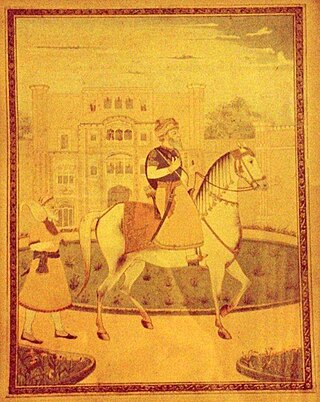Virk is a last name used by Sikhs in Punjab, India, which is based on that of a Jat clan supposedly founded by a Rajput called Virak.
Deol is a Jat surname native to the Punjab region of India.
Soomro, Soomra,Sumrah or Sumra is a tribe having a local origin in Sindh. They are found in Sindh, parts of Punjab especially bordering Sindh, Balochistan province, and the Kutch district of the Indian state of Gujarat and also Rajasthan. The Soomras ruled throughout the Sindh and Multan regions.
Sidhu is a Punjabi Jat clan found in Punjab.
Rai Abdullah Khan Bhatti popularly known through his moniker Dulla or Dullah Bhatti, was a Punjabi folk hero who led a revolt against Mughal rule during the reign of Emperor Akbar. He is entirely absent from the recorded history of the time, and the only evidence of his existence comes from Punjabi folk songs.
Malwa is a geographical region in the south of Punjab state in India. It is located between south of the Sutlej river, north of the Ghaggar river, east of Pakistan, and west of the Sivalik Hills.

Jassa Singh Ahluwalia was a Sikh leader during the period of the Sikh Confederacy, being the supreme leader of the Dal Khalsa. He was also Misldar of the Ahluwalia Misl. This period was an interlude, lasting roughly from the time of the death of Banda Bahadur in 1716 to the founding of the Sikh Empire in 1801. He founded the Kapurthala State in 1772.
Jat Sikh or Jatt Sikh is an ethnoreligious group, a subgroup of the Jat people whose traditional religion is Sikhism, originating from the Indian subcontinent. They are one of the dominant communities in the Punjab, India, owing to their large land holdings. They form an estimated 20–25% of the population of the Indian state of Punjab. They form at least half of the Sikh population in Punjab, with some sources estimating them to be about 60–66% appx. two-third of the Sikh population.
Kalsian, also spelled Kalsiyan or Kalsyan, is a clan of the Gujjar ethnic community based in India and Pakistan.

Haji Muhammad Naushāh Ganj Bakhsh was a Punjabi Muslim Sufi saint and scholar from Gujrat in Pakistani Punjab. He was the founder of the Naushahiah branch of the Qadiriyya Sufi order, and his successors came to be known as Naushāhiyyas.
Rania is a town and a municipal committee in Sirsa district located on the upper bank of Ghaggar River in the Indian state of Haryana. Rania Town is a grain market in Sirsa district. Nearby cities to Rania includes Sirsa and Ellenabad. It shares its RTO office with Ellenabad which is also has its headquarters in Ellenabad. Earlier it was a part of Ellenabad subdivision but later carved out separately as a subdivision in Sirsa district of Haryana. It is at a distance of 22 km each from Sirsa and Ellenabad in opposite direction on Haryana State Highway 32A i.e. Bhambhoor-Jiwan Nagar Road which connects to Haryana State Highway 32 in Jiwan Nagar on one end and Haryana State Highway 23 in Bhambhoor on the other end.

Dhani or Thok is a type of hamlet, the smallest conglomeration of houses, in the sandy Bagar region of the northwestern states of Rajasthan, Haryana and Punjab in India. Per the Census of India, 70% of Indians live in villages. 80% of the villages have a population of less than 1000 people and each consists of a cluster of hamlets. Most dhanis are nucleated settlements, while others are more dispersed. A dhani could be as small as one isolated house for a single family or a small cluster of several houses which could grow in number with successive generations, and even become a village by itself. All families living in a dhani are relatives or at least are of the same caste. An isolated collection of several dhanis, which could be few hundred meters apart, constitutes a gram panchayat. A typical dhani in the arid zone of Rajasthan is a cluster of huts with a boundary made of dried shrubs around it and with owners' livestock such as goats, sheep and camels inside the bara. Dhani are atypically mud huts in Rajasthan. Houses in dani nowadays are made of modern brick and mortar, specially in affluent higher-per-capita-income states of Haryana and Punjab, and some richer families of Rajasthan.
Awana also known as Awan is a clan of the Gurjar ethnic community of India and Pakistan.
Chamayan is also referred to as Chamayin, Chamain or Chaim is a clan of the Gurjar ethnic group found in India and Pakistan. They adhere to many religions, including the Hinduism, Sikhism and Islam.

Sardar Gujjar Singh Bhangi was a Sikh warrior of the Bhangi Misl, and one of the triumvirates who ruled over Lahore prior to the leadership of Maharaja Ranjit Singh.
Dhaliwal, also known as Dhariwal, is a surname and clan found among the Jat Sikhs of Punjab, India. Historically, they were influential Sardars under the Singh Krora Misl during the Sikh Confederacy in India.

The Jat people, also spelt Jaat and Jatt, are a traditionally agricultural community in Northern India and Pakistan. Originally pastoralists in the lower Indus river-valley of Sindh, many Jats migrated north into the Punjab region in late medieval times, and subsequently into the Delhi Territory, northeastern Rajputana, and the western Gangetic Plain in the 17th and 18th centuries. Of Hindu, Muslim and Sikh faiths, they are now found mostly in the Indian states of Punjab, Haryana, Uttar Pradesh and Rajasthan and the Pakistani regions of Sindh, Punjab and AJK.

Brar is a surname, and a Jat clan from the Punjab region.
Bhatti is a Punjabi and Sindhi caste of Jats and Rajputs. They are linked to the Bhatias and Bhuttos, all of whom claim to originate from the Hindu Bhati Rajputs.
Bhatis are a clan of Gurjarsfound primarily in the Indian states of Uttar Pradesh and Haryana and in Punjab, Pakistan.






